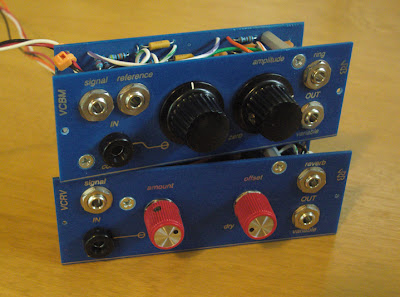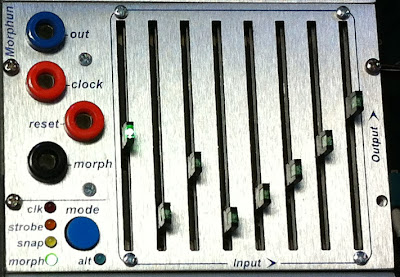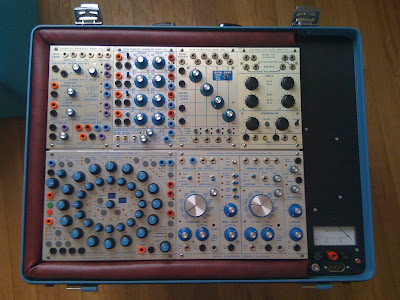Sonntag, 29. April 2012
"Seq-A" and the "Creature"
One of my favorite Modular Videos that features a Serge M-panel system. The Serge Modular is currently manufactured by Sound Transform Systems in Wisconsin. Enjoy!
Intellijel uStep ModuleModule
Intellijel's new ModuleModule is actually a reincarnation of Intellijel's uStep that is already available in the very popular Eurorack format.
features include:
separate sequence lengths (1-8 steps long each) or single 1x16 mode
seperate gate lengths
store/recall patterns (8 locations)
8 levels of shuffle
seperate sequence outputs with dedicated leds showing gate logic status
relative and absolute timing modes
gate range from 500us to 30minutes (capable of audio rate sequences)
use this module for:
beat/trigger sequencing (great for polyrhythms)
control of adsr/asr envelopes
clock dividing
swing clock
convert gate to trigger
Price: $290
Available for direct order from Intellijel HQ.
Please e-mail orders@intellijel.com with your location info for shipping quote
features include:
separate sequence lengths (1-8 steps long each) or single 1x16 mode
seperate gate lengths
store/recall patterns (8 locations)
8 levels of shuffle
seperate sequence outputs with dedicated leds showing gate logic status
relative and absolute timing modes
gate range from 500us to 30minutes (capable of audio rate sequences)
use this module for:
beat/trigger sequencing (great for polyrhythms)
control of adsr/asr envelopes
clock dividing
swing clock
convert gate to trigger
Price: $290
Available for direct order from Intellijel HQ.
Please e-mail orders@intellijel.com with your location info for shipping quote
Montag, 23. April 2012
LZX Industries
A few weeks ago I read more about video synthesis and looked again at the modular video synthesizer that is offered by LZX Visionary. Some of the video's on there homepage that where created with there video synthesizer are really amazing so I thought I share them and there introduction to the system here. I am thinking of buying a small system for myself. Maybe it will work nicely with the Buchla.
LZX Visionary: An Introduction
In today’s era of digital video and computer graphics, tools for the video artist wishing to experiment with the use of analogue circuitry for the creation and processing of images have largely been lost, left to a rich tradition of video artists from the 1960’s and 1970’s. We believe the past several years’ renaissance in the use of analogue synthesizers in music production, and the effectiveness of integrated analogue and digital workflows, to be a precursor to a similar renaissance in video technologies. There is a warmth and immediacy in the analogue, hardware-based video workflow which is lacking within software environments, and video artists worldwide have long been frustrated by lack of access to such tools outside of a few scattered studios. With LZX Visionary, it is our goal to both reintroduce classic vintage video processing and synthesis circuitry, and continually push development of new tools which enhance integration with the tools of the day and fulfill the needs of the modern video artist.
LZX Visionary is a line of EuroRack format synthesizer modules designed for creating and manipulating video and images. While our modules may be augmented within the same system by a wealth of interesting modules from other manufacturers intended for the creation of audio, our goal is to offer a complete system specifically designed for the demands of generating and processing video signals.
While many functional modules are useful for both audio and video, some new module designs must be introduced which deal with the special requirements of video signals. The LZX Visionary modular video synthesizer can function as a traditional video mixer, keyer, or special effects unit, or delve into experimental territory such as the creation of abstract patterns with voltage-controlled oscillators, complex color space modulation, audiovisualization, and many as yet to be discovered techniques.
LZX Visionary: An Introduction
In today’s era of digital video and computer graphics, tools for the video artist wishing to experiment with the use of analogue circuitry for the creation and processing of images have largely been lost, left to a rich tradition of video artists from the 1960’s and 1970’s. We believe the past several years’ renaissance in the use of analogue synthesizers in music production, and the effectiveness of integrated analogue and digital workflows, to be a precursor to a similar renaissance in video technologies. There is a warmth and immediacy in the analogue, hardware-based video workflow which is lacking within software environments, and video artists worldwide have long been frustrated by lack of access to such tools outside of a few scattered studios. With LZX Visionary, it is our goal to both reintroduce classic vintage video processing and synthesis circuitry, and continually push development of new tools which enhance integration with the tools of the day and fulfill the needs of the modern video artist.
LZX Visionary is a line of EuroRack format synthesizer modules designed for creating and manipulating video and images. While our modules may be augmented within the same system by a wealth of interesting modules from other manufacturers intended for the creation of audio, our goal is to offer a complete system specifically designed for the demands of generating and processing video signals.
What is modular video synthesis?
A modular synthesizer is a type of analogue computer which is programmed by connecting the inputs and outputs of various functional modules to each other, typically in order to produce or process audio signals. The advantages of a modular synthesizer are its expandability and flexibility, since a system can be designed around goals the user wishes to achieve, and easily reconfigured (or patched) for multiple uses. Video synthesis is another application of the modular synthesizer, and while the application is different, the same principles of analogue signal paths and voltage-controlled parameters still apply.While many functional modules are useful for both audio and video, some new module designs must be introduced which deal with the special requirements of video signals. The LZX Visionary modular video synthesizer can function as a traditional video mixer, keyer, or special effects unit, or delve into experimental territory such as the creation of abstract patterns with voltage-controlled oscillators, complex color space modulation, audiovisualization, and many as yet to be discovered techniques.
IRCAM's old Buchla 300
I always like this pictures of the old Buchla 300 from IRCAM and the text, especially this part:
"Even in its current place of rest, under quite a bit of dust, it seems to hearken back youthfully to a earlier time before this age of DSP, when men were men and resistors, resistors."
Check out the rest of the pictures here.
"Even in its current place of rest, under quite a bit of dust, it seems to hearken back youthfully to a earlier time before this age of DSP, when men were men and resistors, resistors."
Check out the rest of the pictures here.
Donnerstag, 19. April 2012
ModuleModules
The ModuleModule format for Buchla systems which was introduced by Chris Muir from Eardrill a while a go is on fire at the moment. In the last two weeks alone four new have surfaced. Intellijel has released there uStep for it. Roman F. from Russia a waveshaper based on the Music Easel and now Jason R. Butcher also announced two new modulemodules.
The first is a Balanced Modulator which is based on the original Buchla 285. The second one is a Reverb which uses a spring reverb emulator. Both will sell for 400$. I have too say that they look very tempting and they are also totally hand made. Great stuff!
The first is a Balanced Modulator which is based on the original Buchla 285. The second one is a Reverb which uses a spring reverb emulator. Both will sell for 400$. I have too say that they look very tempting and they are also totally hand made. Great stuff!
Donnerstag, 12. April 2012
Buchla's 257e
The upcoming Buchla 257e will be a new controll voltage processor and will probably fill the gap that the 255 has left behind.
Dienstag, 10. April 2012
Solaris
One of my favorite books is the Polish science fiction novel Solaris by Stanislaw Lem.
First published in Warsaw in 1961, the 1970 Polish-to-French-to-English translation of Solaris is the best-known of Lem's English-translated works. The book, not just for it's time but even now, is far ahead and far beyond a normal science fiction book and shows the ultimate inadequacy of communication between human and non-human species. Solaris, with whom Terran scientists are attempting communication, is almost completely covered with an ocean that is revealed to be a single, planet-encompassing organism. While the scientists are perfoming there experiments the ocean itself is experimenting with the scientists minds and is confronting them with there most painful and repressed thoughts and memories without revealing anything about itself. I have seen both movie adaptions, the one from Andrei Tarkovsky which was released in 1972 and Steven Soderbergh's adaption from the year 2002 which both fail in my opinion to capture the main themes from the book which are Lem's highly philosophical approche too the human self-image and and self-understanding. Lem himself observed that neither feature movie much depicts the extraordinary physical and psychological “alienness” of the Solaris ocean: “I only wanted to create a vision of a human encounter with something that certainly exists, in a mighty manner perhaps, but cannot be reduced to human concepts, ideas or images” I hope that there will be a movie in the future that does the book at least some justice.
First published in Warsaw in 1961, the 1970 Polish-to-French-to-English translation of Solaris is the best-known of Lem's English-translated works. The book, not just for it's time but even now, is far ahead and far beyond a normal science fiction book and shows the ultimate inadequacy of communication between human and non-human species. Solaris, with whom Terran scientists are attempting communication, is almost completely covered with an ocean that is revealed to be a single, planet-encompassing organism. While the scientists are perfoming there experiments the ocean itself is experimenting with the scientists minds and is confronting them with there most painful and repressed thoughts and memories without revealing anything about itself. I have seen both movie adaptions, the one from Andrei Tarkovsky which was released in 1972 and Steven Soderbergh's adaption from the year 2002 which both fail in my opinion to capture the main themes from the book which are Lem's highly philosophical approche too the human self-image and and self-understanding. Lem himself observed that neither feature movie much depicts the extraordinary physical and psychological “alienness” of the Solaris ocean: “I only wanted to create a vision of a human encounter with something that certainly exists, in a mighty manner perhaps, but cannot be reduced to human concepts, ideas or images” I hope that there will be a movie in the future that does the book at least some justice.
Solaristics, wrote Muntius, is a substitute for religion in the space age. It is faith wrapped in the cloak of science, contact, the goal for which we are striving, is as vague and obscure as communion with the saints or the coming of the Messiah.
Montag, 9. April 2012
Eardrill's Morphun
Chris Muir said on muff's that it's only a few week away. I looks beautiful and I love the sliders with the green leds. He wrote that it will go over five octaves, when quantized (actually 64 semitones) and ten volts, when unquantized.
Short Update: Chris Muir just anounced that the Morphun will sell for 475$ and that he is ready too take orders. Check out his Eardrill homepage for more information.
Short Update: Chris Muir just anounced that the Morphun will sell for 475$ and that he is ready too take orders. Check out his Eardrill homepage for more information.
Mittwoch, 4. April 2012
Jason R. Butcher's wonderful Buchla
ether^ra who is the men behind the wonderful blog ether^ra : visual arts, sound manoeuvring & arcana pointed me the way to an other interesting blog by Jason R.Butcher who has a very nice Buchla 200 that he put together over the years. He posted a new picture on his flickr page that shows a Easel like Haliburton case with only six Modules. He is not only useing Buchla 200 modules but also Buchla's 250e Arbitrary Function Generator which is, acording too the Buchla homepage a 16 stage function generator, featuring direct and immediate access to each stages' control and timing voltages. I think it is amazing that one can still, so many decades after the first Buchla was build, use the old modules with the new ones (even though sometimes you need too attenuate or amplify some modules).
The new setup that he is experimenting with consists of the folowing Modules:
Source of Uncertainty Model 266
Quad Function Generator Model 281
Quad Voltage-Controlled Lopass Gate Model 292
Dual Reverb / Equalizer Model 275
(which is quite a rare module and only one of two old modules
that do not fit in the new 200e boats, the other one being the
Dodecamodule Model 212)
250e Arbitrary Function Generator
Programmable Complex Waveform GeneratorModel 259
(which is probably the most expansive Buchla module that one can buy from the old 200 series
but a beauty it is)
Short Update: An anonymus user pointed out that "there are quite a few 200 modules that don't fit in a 200e cabinet without modifications: 208, 248 ,227 ,296 (296 fits only in one position in the 18 and 24 cab)"
The new setup that he is experimenting with consists of the folowing Modules:
Source of Uncertainty Model 266
Quad Function Generator Model 281
Quad Voltage-Controlled Lopass Gate Model 292
Dual Reverb / Equalizer Model 275
(which is quite a rare module and only one of two old modules
that do not fit in the new 200e boats, the other one being the
Dodecamodule Model 212)
250e Arbitrary Function Generator
Programmable Complex Waveform GeneratorModel 259
(which is probably the most expansive Buchla module that one can buy from the old 200 series
but a beauty it is)
Short Update: An anonymus user pointed out that "there are quite a few 200 modules that don't fit in a 200e cabinet without modifications: 208, 248 ,227 ,296 (296 fits only in one position in the 18 and 24 cab)"
Dienstag, 3. April 2012
Zuckerzeit
In the year 1974 the German Krautrock band Cluster (Kluster) released there album Zuckerzeit. I love absolutly everything about this album the harmonics, the guitars, the drum machines. Everything feels so organic and dreamy at the same time. Unfortunately, I don’t have an original pressing, but the 180g re-press sounds great as well. I had the opportunity too see Hans-Joachim Roedelius and Dieter Moebius performing as Cluster and Roedelius on three other occasions as he lives next to my hometown. When they played at Bologna's 10th International Live-Media Festival in 2010 in Italy I also was fortunate enough too meet Richard Lainhart when I took part in a Buchla workshop he did. This was also my first personal encounter with one of Don Buchla's instruments.
The netmage festival was also the biggest experimental music festival I have ever been too and I can only recommend going.
Raum Zeit Hund
A friend of mine made a wonderful short film that has been shown on several experimental film festivals across Europe. There is no music but I love the overall asthetics.
RaumZeitHund
AT / 2010
6 min.
Nikolaus Eckhard's ironic study RaumZeitHund (SpaceTimeDog) is situated in the field of tension between chronophotography and cinematography.
As legend goes, Eadweard Muybridge discovered chronophotography ca. 1870 as the result of a wager. He wanted to prove that a horse had all four legs in the air for a brief moment when in a gallop. In RaumZeitHund Nikolaus Eckhard refers directly to Muybridge's famous photo series 'Animal Locomotions.' A dog, specially trained for this purpose, is filmed on a treadmill in extreme slow motion (150 individual images per second). But in contrast to his role model, Eckhard does not use a slender, athletic greyhound, but rather, a less representative, long-eared brown Alpine Dachsbracke. The hunting dog, which is tethered to a black leather leash, is additionally furnished with black and white circular marks like a crash test dummy. The impression of 'scientific-ness' is further heightened in that the color film is consistently screened entirely without sound.
The dog's movements, which are initially smooth, become increasingly distorted; the animal jerks and flounders ever more acutely. Muybridge was also mentor for the film's complex montage. When presenting his movement studies, the photo pioneer grouped the individual images serially and in a grid pattern. Eckhard likewise arranges all shots in his film in a grid pattern (55 x 277 frames) and scans this matrix with the help of diverse mathematical functions. The dog's appearance hence fluctuates 'between violently controlled marionette and seemingly blithe ballerina' (Eckhard). In the end, likewise the film's climax, the animal floats, in motion, with all four paws in the air. The evidence is there, the wonder is possible.
Abonnieren
Posts (Atom)
















